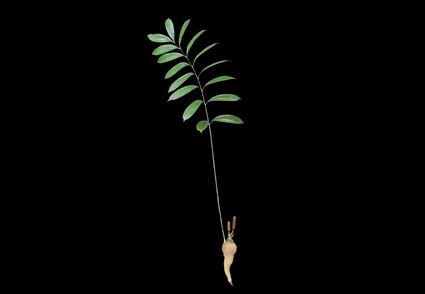Abstract
Zamia orinoquiensis Calonje, Betancur & A.Lindstr., a new species from the western Orinoquía region of Colombia is described and illustrated. The species is segregated from and compared to Z. muricata Willd., the latter which is morphologically recharacterized, illustrated, and recircumscribed to include populations from tropical dry forest and tropical moist forests in the Lara-Falcón Formation and the Cordillera de la Costa natural regions of Venezuela, as well as the Serranía de Macuira in La Guajira, Colombia. Zamia orinoquiensis is morphologically distinguished from Z. muricata by its leaves bearing fewer, coriaceous (vs. papyraceous) leaflets, eophylls with 2 (vs. 4) leaflets, pollen strobili that are brown to reddish brown (vs. cream to tan) with larger microsporophylls bearing more numerous microsporangia, and ovulate strobili that are dark brown to black (vs. dark olive green to olive brown) at maturity.
References
Calonje, M., Stevenson, D.W. & Osborne, R. (2020) The World List of Cycads. Cycads 5: 77–119.
Díaz-Pérez, C.N. & Morales-Puentes, M.E. (2018) Las zamias: plantas con semillas mas antiguas de la tierra. Flora de Aguazul: muestra de diversidad. Grupo Sistemática Biológica (SisBio) UPTC. Available from: https://repositorio.uptc.edu.co/bitstream/001/4269/1/3478.pdf (Accessed 15 November 2021)
Fick, S.E. & Hijmans, R.J. (2017) WorldClim 2: new 1-km spatial resolution climate surfaces for global land areas. International Journal of Climatology 37: 4302–4315. https://doi.org/10.1002/joc.5086
Geiger, R. (1954) Classification of climates after W. Köppen. Landolt-Börnstein – Zahlenwerte und Funktionen aus Physik, Chemie, Astronomie, Geophysik und Technik, alte Serie. Springer, Berlin.
Holdridge, L.R. (1977) Life zone ecology. San José, Costa Rica: IICA. Tropical Science Center.
IUCN Standards and Petitions Committee (2022) Guidelines for using the IUCN Red List Categories and Criteria. Version 15. Prepared by the Standards and Petitions Committee. https://doi.org/10.5962/p.37027
Karger, D.N., Conrad, O., Bohner, J., Kawohl, T., Kreft, H., Soria-Auza, R.W., Zimmermann, N.E., Linder, H.P. & Kessler, M. (2017) Climatologies at high resolution for the earth’s land surface areas. Sci Data 4: 170122. https://doi.org/10.1038/sdata.2017.122
Köppen, W. (1918) Klassification der Klimate nach Temperatur, Niederschlag and Jahreslauf. Petermanns Geographische Mitteilungen 64: 193–203, 243–248.
Kottek, M., Grieser, J., Beck, C., Rudolf, B. & Rubel, F. (2006) World Map of the Köppen-Geiger climate classification updated. Meteorologische Zeitschrift 15: 259–263. https://doi.org/10.1127/0941-2948/2006/0130
López-Gallego, C. (2015) Plan de acción para la conservación de las zamias de Colombia. Bogotá, D.C., Colombia: Ministerio de ambiente y desarrollo sostenible, Colombia - Universidad de Antioquia.
Ospina, D.R. (2005) La Orinoquia de Colombia. Banco de Occidente Credencial, Bogotá, 190 pp.
Sandwith, N.Y. (1925) Humboldt and Bonpland’s Itinerary in Venezuela. Bulletin of Miscellaneous Information (Royal Botanic Gardens, Kew) 1925: 295–310. https://doi.org/10.2307/4107508
Schneider, C.A., Rasband, W.S. & Eliceiri, K.W. (2012) NIH Image to ImageJ: 25 years of image analysis. Nature Methods 9 (7): 671–675. https://doi.org/10.1038/nmeth.2089
Steyermark, J. (1994) Flora del parque nacional Morrocoy. Caracas: Fundación Instituto Botánico de Venezuela : Agencia Española de Cooperación Internacional.
Sugden, A.M. (1982) The Vegetation of the Serranía de Macuira, Guajira, Colombia: A Contrast of Arid Lowlands and an Isolated Cloud Forest. Journal of the Arnold Arboretum 63: 1–30. https://doi.org/10.5962/p.37027
Thiers, B. (2020) Index Herbariorum. Part I: The herbaria of the world. New York Botanical Garden. Available from: https://www. sweetgum.nybg.org/ih (accessed 7 July 2022)
Willdenow, C.L. (1806) Caroli a Linné Species Plantarum exhibentes plantas rite cognitas adgenera relatas cum differentiis specificis, nominibus trivialibus, synonymis selectislocis natalibus, secundum systema sexuale digestas, editio quarta 4 (2). G.C. Nauk, Berlin.


